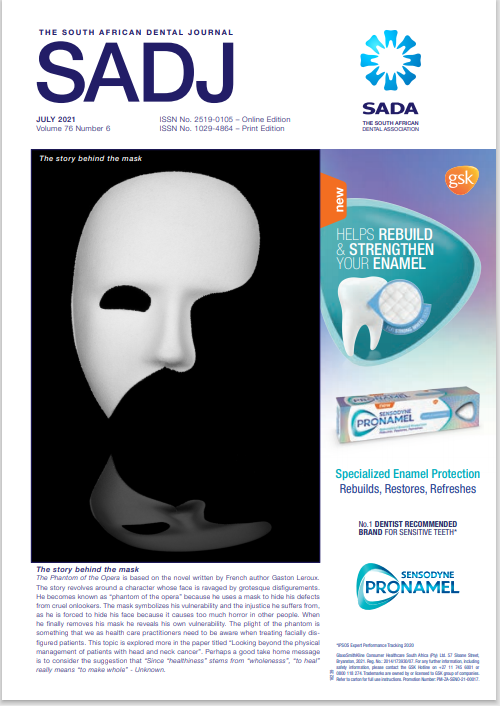Looking beyond the physical management of patients with head and neck cancer
DOI:
https://doi.org/10.17159/2519-0105/2021/v76no6a10Keywords:
multidisciplinary, psychosocial, institutionsAbstract
Cancers of the head and neck region often leave patients with conspicuous defects, as well as limitations in physical
and psycho-social functions. Rehabilitation is challenging and can never fully restore the anatomical, physiological, or
functional characteristics that have been lost. Ideally newly diagnosed cancer patients should be managed by a multidisciplinary team of specialists from various allied fields who will be able to educate them and help them decide on the most appropriate and suitable treatment options. Patients must understand the processes, be of possible side effects and comprehend the limitations
aware of rehabilitation. At the same time, clinicians may need to consider issues of distributive justice when deciding which patients will receive which resources, especially in financially limited institutions and countries. The biggest challenge to us as clinicians as well as community members is to try and treat all patients holistically and to address both their physical and psychosocial needs. This requires a fervent commitment to action, and that we all stand together and help each other through
difficult times.
Downloads
References
Gilyoma JM, Rambau PF, Masalu N et al. Head and neck cancers: a clinic-pathological profile and management challenges in a resource-limiting setting. BMC Res Notes. 2015; 8: 772. DOI: https://doi.org/10.1186/s13104-015-1773-9
Davis TC, Williams MV, Marin E, Parker RM et al. Health literacy and cancer communication. A Cancer Journal for Clinicians. 2002; 52(3): 134-49. DOI: https://doi.org/10.3322/canjclin.52.3.134
De Sousa A. Psychological issues in oral and maxillofacial reconstructive surgery. Science Direct. 2008; 46: 661-4. DOI: https://doi.org/10.1016/j.bjoms.2008.07.192
Moodley K and Naidoo S. Ethics and the dental team. Pretoria, Van Schaik publishers. 2010. 38-41.
Beauchamp TI, Childress JF. Principles of Biomedical Ethics. 5th Ed. New York: Oxford University Press. 2001.
Levine E, Degutis L, Pruzinsky T. et al. Quality of life and facial trauma: psychological and body image effects. Ann Plas Surg. 2005; 54: 502-10. DOI: https://doi.org/10.1097/01.sap.0000155282.48465.94
Reed J, Robathan M, Hockenhull M, et al. Children’s attitudes towards interacting with peers with different craniofacial anomalies. Cleft Palate Craniofac J. 1999; 36: 441-7. DOI: https://doi.org/10.1597/1545-1569(1999)036<0441:CSATIW>2.3.CO;2
Constitution of the World Health Organization. In: World Health Organization: Basic documents. 45th ed. Geneva: World Health
Organization. 2005.
Sartorius N. The meanings of health and its promotion. Croat Med J. 2006; 57(4): 662-4.
Twigg JA, Anderson JM, Huphris G, et al. Best practice in reducing the suicide risk in head and neck cancer patients: a structured review. British Journal of Oral and Maxillofacial Surgery. 2020; 58: e6-e15 DOI: https://doi.org/10.1016/j.bjoms.2020.06.035
Downloads
Published
Issue
Section
License
Copyright (c) 2021 Leanne M Sykes, Tshegofatso V Ntseke, Portia T Nethononda

This work is licensed under a Creative Commons Attribution-NonCommercial 4.0 International License.





.png)